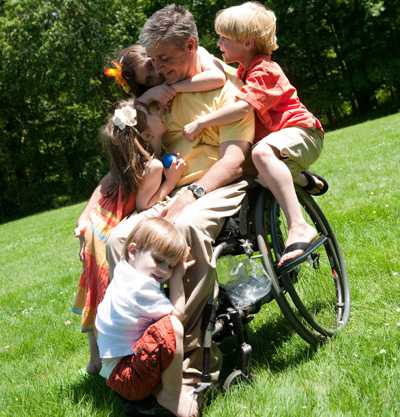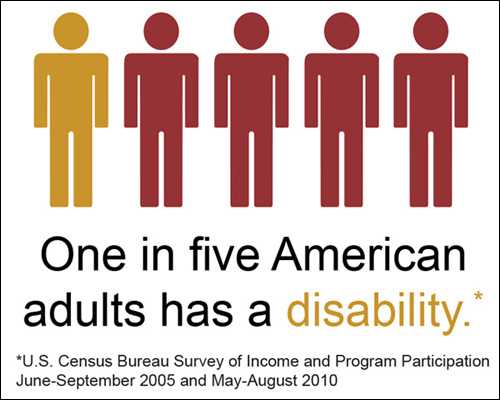Disability Inclusion

Disability Inclusion: Making sure everybody has the same opportunities to participate in every aspect of life to the best of their abilities and desires.
What is Disability Inclusion?
Including people with disabilities in everyday activities and encouraging them to have roles similar to their peers who do not have a disability is disability inclusion. This involves more than simply encouraging people; it requires making sure that adequate policies and practices are in effect in a community or organization.
Inclusion should lead to increased participation in socially expected life roles and activities—such as being a student, worker, friend, community member, patient, spouse, partner, or parent.
Socially expected activities may also include engaging in social activities, using public resources such as transportation and libraries, moving about within communities, receiving adequate health care, having relationships, and enjoying other day-to-day activities.
Disability Inclusion and the Health of People with Disabilities
Disability inclusion allows for people with disabilities to take advantage of the benefits of the same health promotion and prevention activities experienced by people who do not have a disability. Examples of these activities include:
- Education and counselling programs that promote physical activity, improve nutrition or reduce the use of tobacco, alcohol or drugs; and
- Blood pressure and cholesterol assessment during annual health exams, and screening for illnesses such as cancer, diabetes, and heart disease.
Including people with disabilities in these activities begins with identifying and eliminating barriers to their participation.

Why is This Important?
Disability affects approximate 56.7 million, or nearly 1 in 5 (18.7%) people in the United States living in communities. Disability affects more than one billion people worldwide.1,2 According to the United Nations Convention on the Rights of Persons with Disabilities, people “. . . with disabilities include those who have long-term physical, mental, intellectual or sensory [such as hearing or vision] impairments which in interaction with various barriers may hinder their full and effective participation in society on an equal basis with others.” 3
People with disabilities experience significant disadvantages when it comes to health such as:
- Adults with disabilities are three times more likely to have heart disease, stroke, diabetes, or cancer than adults without disabilities;4
- Adults with disabilities are more likely than adults without disabilities to be current smokers;5 and
- Women with disabilities are less likely than women without disabilities to have received a breast cancer X-ray test (mammogram) during the past 2 years. 6
Although disability is associated with health conditions (such as arthritis, mental, or emotional conditions) or events (such as injuries), the functioning, health, independence, and engagement in society of people with disabilities can vary depending on several factors:
- Severity of the underlying impairment
- Social, political, and cultural influences and expectations
- Aspects of natural and built surroundings
- Availability of assistive technology and devices
- Family and community support and engagement
Disability inclusion means understanding the relationship between the way people function and how they participate in society, and making sure everybody has the same opportunities to participate in every aspect of life to the best of their abilities and desires.
References
- Brault, Matthew W., “Americans With Disabilities: 2010,” Current Population Reports, P70-131, U.S. Census Bureau, Washington, DC, 2012. Available at http://www.nasuad.org/sites/nasuad/files/hcbs/files/218/10869/Americans_with_disabilities_2010.pdf; access January 7, 2015. Based on Survey of Income and Program Participation, U.S. Census Bureau, 2010.
- UN World Health Organization (WHO), World Report on Disability : Summary, 2011,WHO/NMH/VIP/11.01,available at: http://www.refworld.org/docid/50854a322.html; accessed January 7, 2015
- United Nations. United Nations Convention on the Rights of Persons with Disabilities. Article 1 – Purpose. Available at http://www.un.org/disabilities/documents/convention/convention_accessible_pdf.pdf; accessed January 7, 2015.
- 2.Carroll D, Courtney-Long E, Stevens A, Sloan M, Lullo C, Visser S, Fox M, Armour B, Campbell V, Brown D, and Dorn, J. Disability and Physical Activity – United States, 2009-2012. Morbidity and Mortality Weekly Report. 2014.
- Courtney-Long E, Stevens A, Caraballo R, Ramon I, Armour BS. Disparities in Current Cigarette Smoking Prevalence by Type of Disability. Public Health Reports. 2014 May/June; 129(3):252-60.
- Courtney-Long E, Armour B, Frammartino B, Miller J. Factors associated with self-reported mammography use for women with and women without a disability. Journal of Women’s Health. 2011; 20:1279-1286
Related Pages
- Commit to inclusion
- National Center on Health, Physical Activity, and Disability (NCHPAD): Guidelines for Disability Inclusion in Programs and Policies
- Public Health is for Everyone
- CDC’s Disability and Health Program
- CDC Diversity and Inclusion Management
- CDC Reasonable Accommodation Services
- Page last reviewed: August 1, 2017
- Page last updated: August 1, 2017
- Content source:




 ShareCompartir
ShareCompartir